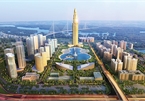 |
| The smart traffic monitoring and operation centre in HCM City. — VNA/VNS Photo Tien Luc |
Reviewing the last three years of the city-wide emulation movement to ensure traffic order and safety and its future tasks, the city's leader emphasised that many civil servants, public employees, organisation and individuals have contributed to the movement.
He said that the city should promote IT application in traffic management and operation to help detect and handle traffic violations.
The city plans to mobilise resources to invest in major transport projects, focusing on inter-regional road projects and improving the efficiency of inland waterways and railways, he noted.
Tran Quang Lam, director of the city’s Department of Transport, said the movement has achieved positive results, contributing to reducing the number of traffic accidents, fatalities and injuries.
Compared with figures in the previous year, the number of traffic accidents fell by 10.5 per cent, deaths by 4 per cent, and injured victims by nearly 29 per cent in 2018.
In 2019, the number of traffic accidents fell by 5.5 per cent, deaths by 10.3 per cent, and injured victims by 2.7 per cent.
In the first nine months of the year, the number of traffic accidents dropped by 13.8 per cent and deaths by 14.1 per cent, while the number of injured victims decreased by 12.4 per cent, compared with the same period last year.
Fifty-seven traffic works worth more than VND11 trillion (US$474.6 million) were completed and put into use.
These new works will help reduce traffic jams in hotspots such as areas around Tan Son Nhat International Airport in Tan Binh District, Cat Lai Port in District 2, and the access road to HCM City - Long Thanh - Dau Giay Expressway between HCM City and Dong Nai Province.
Last year, the city opened the first phase of a smart traffic monitoring and operation centre, the first of its kind in the country applying modern technology to traffic management.
The BusMap app, which has information on public bus routes and bus arrival times, has attracted more than 870,000 downloads.
The city has also begun trial use of e-tickets on public buses, and installed automatic payment systems on 162 buses on 62 bus routes.
In addition, parking fees on 23 streets are collected automatically through MyParking or ViettelPay apps on drivers' smart devices.
Roadblocks
Despite these measures, the increasing number of private vehicles is putting pressure on the city’s transport infrastructure.
Illegal parking areas and street-side vendors continue to encroach upon sidewalks and roads, and lack adequate supervision and inspection.
Phong asked State management offices to improve management activities to ensure traffic order and safety.
Research on urban traffic management models suited to the city’s current situation should be completed. And, solutions are needed to eliminate so-called black spots where traffic accidents and congestion occur regularly in the city, he said.
More attention should also be paid to improving the quality of public transport services and control the number of personal vehicles in urban areas.
The second phase of the smart traffic monitoring and operation centre is expected to be completed by 2025. VNS

Technology key to success for HCM City's smart transport system
After two years of applying technology to traffic management, HCM City’s goal to develop a smart transport system, one of the key components of its smart city project, has achieved success.

Vietnam pushes on with smart city plans
Vietnam is accelerating construction to support establishment of smart city projects combined with top-class technology to enhance both the country’s management and the economy.